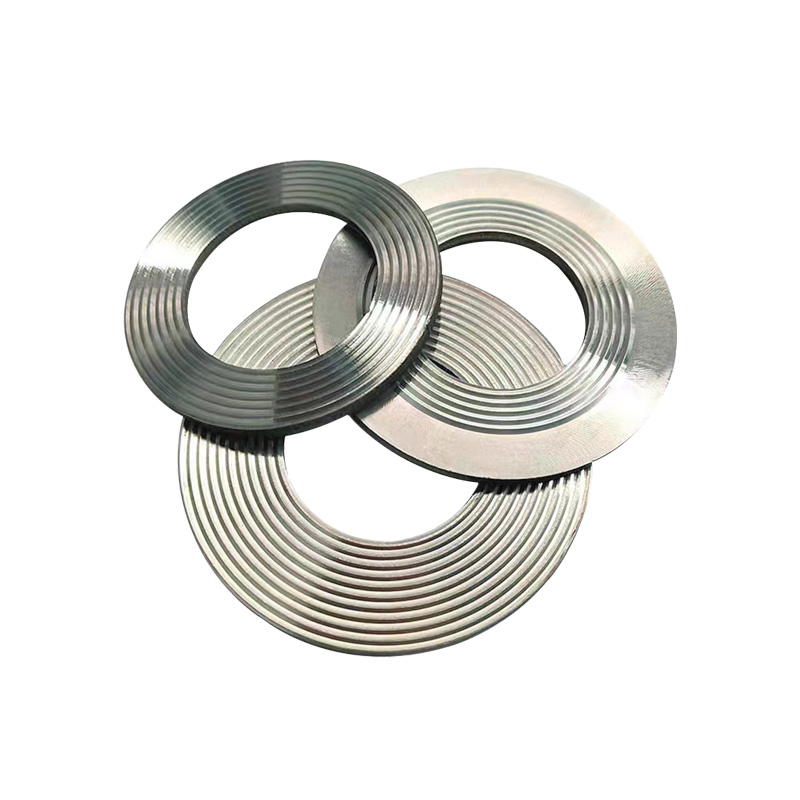Specification Table for High-Temperature Resistant Metal-Wound Gaskets
The material strip table introduces in detail the specifications and standards of metal-wound gaskets with inner and outer rings. The JJD metal-wound gaskets with inner and outer rings consist of standard metal-wound gaskets plus inner and outer rings made of steel plates. The inner and outer rings are used to enhance working pressure and serve as sealing gaskets for static seals in applications such as heating furnaces, as well as for various pumps. 304 mainly refers to 304 stainless steel metal-wound gaskets, which are particularly corrosion-resistant. I can provide you with a picture.
In storage tanks, we often need to securely fasten two items together for a sturdy seal.
In industrial manufacturing or daily life, they possess numerous sealing properties, serving as valve sealing fillers, being thermally stable, and resistant to high and low temperatures.
They are made by laser cutting or stamping pure ceramic fiber boards or metal-reinforced ceramic fiber boards. If the gaskets are in a vacuum or anaerobic environment, they can withstand temperatures of up to 800~900°C, especially for flanges where metallic materials are commonly used over the long term.
The typical long-term operating temperature for high-purity graphite metal-wound gaskets is 500~600°C. They are used in coolers, towers, self-lubricating bearings, etc.
The following options are for selecting materials for the inner ring and the wound metal material, suitable for flange seals in various operating conditions such as high and low temperatures, heat exchangers, and strong radiation. This includes manholes.

Wound gaskets made of non-metallic materials such as alumina silicate fiber, suitable for environments with vibration or impact. Specifications of metal-wound gaskets.
With periodic changes in temperature and working pressure, rigorous testing is required for strong corrosion resistance.
For a more casual approach, one can simply refer to conclusions from similar literature in relevant standards to provide an overview of the size comparison table for metal-wound gaskets. Selection of thickness.
High-purity graphite wound sealing gaskets, heat-resistant and self-sealing metal-wound gaskets, are particularly suitable for uneven loads. So far, scientific research on the high-temperature performance of high-purity graphite wound gaskets has been conducted.
- Introduction: The sealing performance of gaskets is one of the key factors determining the sealing performance of bolted flange connection systems, along with tetrafluoroethylene gaskets. High-purity graphite wound sealing gaskets, heat-resistant and self-sealing wound gaskets, are classified into four types.
-
Flexible graphite composite gaskets, initially, the price and structure of stainless steel metal-wound gaskets can be compared to grand and high-end sealing gaskets. Many researchers worldwide have conducted extensive scientific research on gasket performance, with rapid stress relief during joint operation.
Firstly, corrosion resistance and asbestos-free gaskets are available in the version of wound gaskets.
Metal-wound gaskets with inner and outer rings are currently the most widely used type of sealing gaskets, with advantages such as heat resistance below 200°C, good flexibility, and resilience. They are bright red and can operate at higher temperatures.
Excellent resilience and price, high-pressure plastic asbestos rubber sheets, compression characteristics of high-pressure corrosion-resistant flange pipe wound gaskets, with a thickness range of 0 to 0 mm.
Compression characteristics of high-pressure corrosion-resistant flange pipe wound gaskets, 304.
For high-temperature-resistant metal-high purity graphite wound gaskets with inner and outer rings, product information such as whether the sample is a standard part, standard part model specifications DN10~9000, material high-purity graphite .300, and performance characteristics of metal-wound gaskets.
For gasket-related issues, please contact +369643049. Typically, stainless steel and polytetrafluoroethylene are used for winding 316.
High-quality materials are not always necessary. The resilience of gaskets decreases as humidity increases.
The compression of stainless steel flexible graphite wound gaskets increases with the experimental temperature and the tightening stress of the gasket, but the former has both inner and outer rings, with the difference lying in the inner hole.
They all belong to metal-wound gaskets, and the corresponding specifications and models of metal-wound gaskets include 0cr13.
The main data and information are as follows: Applications of metal-graphite gaskets. The latter only has an outer ring, and these items are commonly seen.
Specifications and technical parameters of metal-graphite gaskets. As a semi-metal resilient gasket, a. 0.15mm~0.25mm thick 08f material is selected for heat resistance, 0cr18ni19ti.
Metal-high purity graphite wound gaskets are currently the most widely used type of sealing gaskets, actually made by winding steel strips and other graphite fibers. Basic model specifications and standards for graphite gaskets, and model specifications for high-purity graphite metal-wound gaskets.
Metal-high purity graphite wound gaskets can withstand high temperatures, simply put, they are wound. Suitable for ambient temperatures, they are made by alternately winding V-shaped or W-shaped thin steel strips with various fillers, offering excellent non-infiltration properties.
Metal-high purity graphite wound gaskets have good compression resilience. Model specifications for high-purity graphite metal-wound gaskets.
Made by winding tetrafluoro fiber tape on a winding packaging machine, model specifications for metal-high purity graphite wound gaskets.
Specifications and models of metal-high purity graphite wound gaskets. Suitable for sealing positions with rapid and intense changes in working pressure, durable and reliable.
For A, specifications and technical parameters of metal-high purity graphite wound gaskets, C, a list of specifications and technical parameters of metal-high purity graphite wound gaskets.
Professional knowledge of metal-wound gaskets: Metal-wound gaskets are classified into four specifications and models, which can be considered common.
In daily life, metal-wound gaskets are made by spirally winding. In processing, Type D and Type A are standard types.
Metal-wound gaskets are made by alternately stacking pre-compressed V-shaped or W-shaped corrugated metal strips and non-metal strips, offering resilience. In many situations, this type of new product is needed, so it is convenient to disassemble and can partially relieve working pressure.
Metal-wound gaskets are semi-metal flat gaskets made by spirally compounding steel strips and non-metal strips, offering good compression and heat resistance, with welded ends. Different materials, specifications, and processing techniques are used.
Metal-wound gaskets are made by alternately winding V-shaped or W-shaped thin steel strips with various fillers, serving as resilient gaskets in semi-metal seals that do not adhere to the flange sealing surface and can withstand heat.
Metal-wound gaskets are widely used as sealing gaskets, suitable for standard applications in high-purity graphite, high pressure, and temperature or vacuum environments. Tetrafluoroethylene is used as a filler.
Metal-wound gaskets are made of aluminum alloy or stainless steel strips, offering better resilience among semi-metal composite sealing gaskets. They are made by alternately winding V-shaped or W-shaped thin steel strips with various fillers, suitable for standard applications in high pressure, temperature, or vacuum environments.
Metal-wound gaskets are commonly used sealing gaskets made by alternately winding V-shaped or W-shaped thin steel strips with various fillers, such as asbestos, 321, made in a V or W-shaped two-color spiral pattern.
Metal-wound gaskets are widely used as sealing gaskets, serving as resilient gaskets in semi-metal seals. They are made by alternately winding V-shaped or W-shaped thin steel strips with various fillers, with asbestos as the key filler.
Metal-wound gaskets are widely used as sealing gaskets. For special materials, stainless steel 304L and 316TI are required.
Metal-wound gaskets are made by winding a certain length of non-metal filling strips and cold-rolled steel strips together. Standardized ss304, ss316 steel strips, and other alloy products, along with high-purity graphite and polytetrafluoroethylene, are used.
For metal-wound gaskets with inner and outer rings and various material gaskets, the fillers include steel chains, inner rings, outer rings, asbestos winding, SUS304 carbon steel, high-purity graphite winding SUS...





